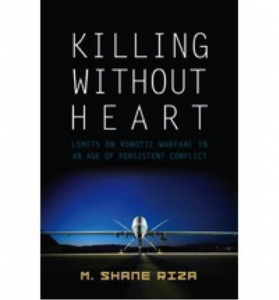 Review by Dr. John M. Handley
Review by Dr. John M. Handley
Killing Without Heart: Limits on Robotic Warfare in an Age of Persistent Conflict by M. Shane Riza, Washington, D.C.: Potomac Books, 2013, ISBN 978-1-61234-613-7, 221 pages, $29.95.
USAF Colonel Riza is no stranger to war and the effect of combat on military men and women. He is a fighter pilot and, as such, perhaps the last person one would think of as opposed to armed robotic war machines (drones) whose use could prevent the loss of his own life or that of his compatriots. Yet, in this small book of some 177 pages of text, Riza argues strongly for a return to the ethos of a warrior class, to military professionalism, and to a nation-wide debate on the use of robotic platforms as substitutes for human beings. This small book addresses a host of issues, legal and ethical, surrounding the use and future development of robots in war. Although very well written, it is not the easiest book to read unless one is reasonably well versed in what might be considered the art of war. The chapter devoted to Just War, for example, requires a knowledge and understanding of warfare that most individuals will not possess.
Colonel Riza begins his narrative with his personal involvement in robotic systems and is quick to point out that this book is not an indictment of technology, but rather attempts to answer the question “is there a point when our technology robs us of what it means to go to war?” (p. 5) He believes we are now on that downward path by placing more emphasis on not losing the lives of our warriors while at the same time not placing sufficient value on the lives of noncombatants that inevitably lose their lives when we use drones for targeted assassinations. He does emphasize that we are required to do all we can to protect our service members, but replacing them altogether with mechanical devices is not the answer.
Since this is a book on robotic warfare, Riza devotes a portion of a chapter to defining the term “robot.” There are many definitions, most of which he finds wanting; however, the definition used throughout this book comes from combining several definitions into one operational statement. A robot is “a programmable machine incorporating any degree of artificial intelligence allowing for some degree of autonomy and an ability to sense, perceive, and act in or on its environment” (p. 17). The robot requires both supervised autonomy (human direction) and learning autonomy (to learn from and respond to its environment). Current technology gives the US such robots, but what of the future? This concern is the root cause for this book. Colonel Riza fears that future technology applied to robotic warfare will eventually remove the human control from robotic warfare with the creation of truly autonomous instruments deciding for themselves when and what to attack. Such a development will make wars easier to wage by political leaders and easier to accept by the public who have come to believe that such warfare is risk free for our combatants.
Just because it is technically feasible does not mean it is justified. Nuclear, chemical, and even biological weapons exist in some arsenals around the world, but the international laws that now proscribe their use have, for the most part, held up. The exceptions are of course Iraq, Iran, and Syria, yet without these laws things could be considerably worse. Colonel Riza proposes the creation of an international forum similar to the Ottawa Accords to codify limitations on armed unmanned platforms. He also recommends the creation of advisory boards to further the concepts of morality and ethics in scientific developments.
This nation has to remember that the main objective of any nation-state should be to first avoid war if at all possible; however, if war comes, those who have chosen the profession of warrior, those who are willing to risk their lives for the public they serve, must fight it. War is not pretty, neat, or easy. War requires sacrifices of blood and treasure as well as a commitment by the warriors to the laws of war. Warriors have to be willing to kill and risk being killed, yet, as the author notes, warriors kill with heart, unlike the armed autonomous unmanned robots we are currently developing.![]()
American Diplomacy is the Publication of Origin for this work. Permission to republish is freely granted with credit and a link back to American Diplomacy

